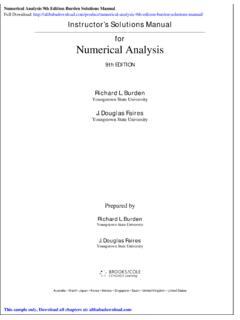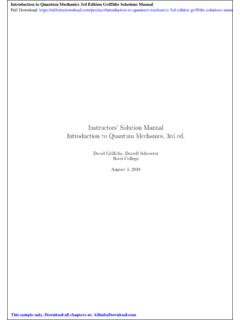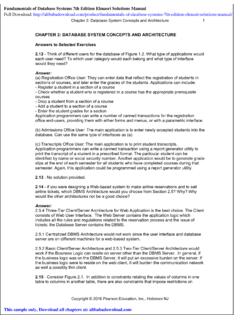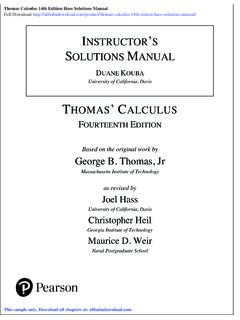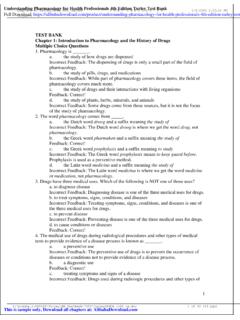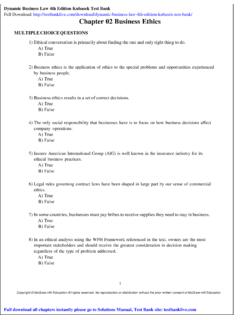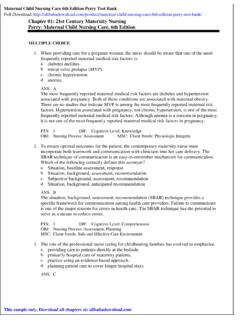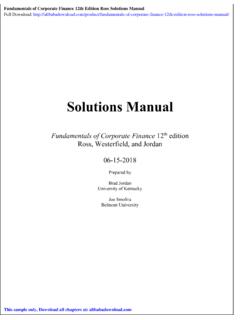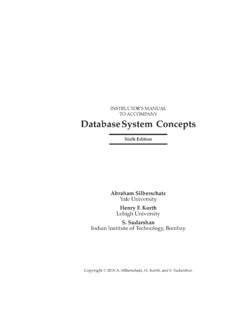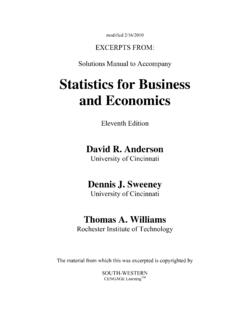Transcription of Understanding Basic Statistics 8th Edition Brase Solutions ...
1 Complete Solutions manual to accompany Understanding Basic Statistics EIGHTH Edition Charles Brase Regis University, Denver, CO Corrinne Brase Arapahoe Community College Littleton, CO Prepared by Melissa M. Sovak California University of Pennsylvania, California, PA Australia Brazil Mexico Singapore United Kingdom United States Cengage Learning. All rights reserved. No distribution allowed without express Basic Statistics 8th Edition Brase Solutions ManualFull Download: sample only, Download all chapters at: Printed in the United States of America 1 2 3 4 5 6 7 17 16 15 14 13 2019 Cengage Learning ALL RIGHTS RESERVED. No part of this work covered by the copyright herein may be reproduced, transmitted, stored, or used in any form or by any means graphic, electronic, or mechanical, including but not limited to photocopying, recording, scanning, digitizing, taping, Web distribution, information networks, or information storage and retrieval systems, except as permitted under Section 107 or 108 of the 1976 United States Copyright Act, without the prior written permission of the publisher except as may be permitted by the license terms below.
2 For product information and technology assistance, contact us at Cengage Learning Customer & Sales Support, permission to use material from this text or product, submit all requests online at Further permissions questions can be emailed to ISBN-13: 978-133755811-2 ISBN-10: 1-33755811-7 Cengage Learning 20 Channel Center Street Boston, MA 02210 USA Cengage Learning is a leading provider of customized learning Solutions with office locations around the globe, including Singapore, the United Kingdom, Australia, Mexico, Brazil, and Japan. Locate your local office at: Cengage Learning products are represented in Canada by Nelson Education, Ltd. To learn more about Cengage Learning Solutions , visit Purchase any of our products at your local college store or at our preferred online store NOTE: UNDER NO CIRCUMSTANCES MAY THIS MATERIAL OR ANY PORTION THEREOF BE SOLD, LICENSED, AUCTIONED, OR OTHERWISE REDISTRIBUTED EXCEPT AS MAY BE PERMITTED BY THE LICENSE TERMS HEREIN.
3 READ IMPORTANT LICENSE INFORMATION Dear Professor or Other Supplement Recipient: Cengage Learning has provided you with this product (the Supplement ) for your review and, to the extent that you adopt the associated textbook for use in connection with your course (the Course ), you and your students who purchase the textbook may use the Supplement as described below. Cengage Learning has established these use limitations in response to concerns raised by authors, professors, and other users regarding the pedagogical problems stemming from unlimited distribution of Supplements. Cengage Learning hereby grants you a nontransferable license to use the Supplement in connection with the Course, subject to the following conditions. The Supplement is for your personal, noncommercial use only and may not be reproduced, or distributed, except that portions of the Supplement may be provided to your students in connection with your instruction of the Course, so long as such students are advised that they may not copy or distribute any portion of the Supplement to any third party.
4 Test banks, and other testing materials may be made available in the classroom and collected at the end of each class session, or posted electronically as described herein. Any material posted electronically must be through a password-protected site, with all copy and download functionality disabled, and accessible solely by your students who have purchased the associated textbook for the Course. You may not sell, license, auction, or otherwise redistribute the Supplement in any form. We ask that you take reasonable steps to protect the Supplement from unauthorized use, reproduction, or distribution. Your use of the Supplement indicates your acceptance of the conditions set forth in this Agreement. If you do not accept these conditions, you must return the Supplement unused within 30 days of receipt. All rights (including without limitation, copyrights, patents, and trade secrets) in the Supplement are and will remain the sole and exclusive property of Cengage Learning and/or its licensors.
5 The Supplement is furnished by Cengage Learning on an as is basis without any warranties, express or implied. This Agreement will be governed by and construed pursuant to the laws of the State of New York, without regard to such State s conflict of law rules. Thank you for your assistance in helping to safeguard the integrity of the content contained in this Supplement. We trust you find the Supplement a useful teaching tool. Contents Chapter 1: Getting Started .. 1 Chapter 2: Organizing Data .. 6 Chapter 3: Averages and Variation .. 31 Chapter 4: Correlation and Regression .. 53 Chapter 5: Elementary Probability Theory .. 75 Chapter 6: The Binomial Probability Distribution and Related Topics .. 97 Chapter 7: Normal Curves and Sampling Distributions .. 122 Chapter 8: Estimation .. 152 Chapter 9: Hypothesis Testing .. 175 Chapter 10: Inferences about Differences .. 208 Chapter 11: Additional Topics Using Inference.
6 245 1 Chapter 1: Getting Started Section 1. Individuals are people or objects included in the study, while a variable is a characteristic of the individual that is measured or observed. 2. Nominal data are always qualitative. 3. A parameter is a numerical measure that describes a population. A statistic is a numerical value that describes a sample. 4. If the population does not change, the values of the parameters will not change. Thus, for a fixed population, parameter values are constant. If we take three samples of the same size from a population, the values of the sample Statistics will almost surely differ. 5. (a) These numerical assignments are at the nominal level. There is no apparent ordering in the responses. (b) These numerical assignments are at the ordinal level. There is an increasing relationship from worst to best levels of service. These assignments are not at the interval or ratio level. The distances between numerical responses are not meaningful.
7 The ratios are also not meaningful. 6. Lucy s observations do not apply to all adults; they apply only to her friends. Since the sample is not random, we cannot draw any conclusions about a larger group using this data. 7. (a) Meal ordered at fast-food restaurants. (b) Qualitative (c) Response for all adult fast-food consumers. 8. (a) Miles per gallon. (b) quantitative . (c) All new small hybrid cars. 9. (a) Nitrogen concentration (milligrams of nitrogen per liter of water). (b) quantitative . (c) Nitrogen concentration in the entire lake. 10. (a) Number of ferromagnetic artifacts per 100 square meters. (b) quantitative . (c) The number of ferromagnetic artifacts per each distinct 100-square-meter plot in the Tara region. 11. (a) Ratio. (b) Interval. (c) Nominal. (d) Ordinal. (e) Ratio. (f) Ratio. 12. (a) Ordinal. (b) Ratio. (c) Nominal. (d) Interval. (e) Ratio. (f) Nominal. 13. (a) Nominal.
8 (b) Ratio. (c) Interval. (d) Ordinal. (e) Ratio. (f) Interval. 14. Form B is better. Statistical methods can be applied to the ordinal data obtained from Form B but not to the open-response answers obtained from Form A. 15. (a) Answers vary. Ideally, weigh the packs in pounds using a digital scale that has tenths of pounds for accuracy. (b) Some students may refuse to have their backpacks weighed. (c) Informing students before class may cause students to remove items before class. NOT FOR SALENOT FOR SALE2 Section 1. In stratified samples, we select a random sample from each stratum. In cluster sampling, we randomly select clusters to be included, and then each member of the cluster is sampled. 2. In simple random samples, every sample of size n has an equal chance of being selected. In a systematic sample, the only possible samples are those including every kth member of the population with respect to the random starting position.
9 3. Sampling error is the difference between the value of the population parameter and the value of the sample statistic that stems from the random selection process. The term is being used incorrectly here. Certainly larger boxes of cereal will cost more than smaller boxes of cereal. 4. The sample frame consists of students who use the college recreation center. No, some students may not use the recreation center. 5. No, even though the sample is random, some students younger than 18 or older than 20 may not have been included in the sample. 6. No, a random sample could include only music majors. 7. (a) Stratified. (b) No, because each pooled sample would have 100 season ticket holders from men s basketball games and 100 for women s basketball games. Samples, for example, with 125 ticket holders for men s basketball games and 75 for women s games are not possible. 8. (a) Yes. Every student has a 50% chance of being selected. (b) It is not possible based on this method of selecting students.
10 Since every sample of size 20 is not possible, this is not a simple random sample. (c) Assign numbers 1, 2, .., 40 to the students and use a random-digits table or a computer package to draw random numbers. 9. Simply use a random digits table or a computer package to randomly select four students from the class. (a) Answers vary. Perhaps they are excellent students who make an effort to get to class early. (b) Answers vary. Perhaps they are busy students who are never on time to class. (c) Answers vary. Perhaps students in the back row are introverted. (d) Answers vary. Perhaps taller students are healthier. 10. (a) Students who are absent from class on Monday cannot be included in the sample. (b) Home-schooled students, drop out students, or homeless students cannot be included in the sample. 11. Answers vary. 12. Answers vary. 13. Answers vary. 14. Answers vary. One possibility is to use 0, 1, 2, 3, and 4 to indicate heads, and 5, 6, 7, 8, and 9 to indicate tails.
